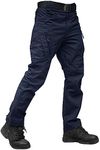Buying Guide for the Best Tactical Pants
Choosing the right tactical pants is all about matching your needs with the features that matter most for your activities. Tactical pants are designed for durability, comfort, and utility, making them popular for outdoor adventures, work, and everyday wear. To find the best pair, you should consider where and how you’ll use them, what kind of movement or tasks you’ll be doing, and what features will make your experience better. Understanding the key specifications will help you make a smart choice that keeps you comfortable and prepared.MaterialMaterial refers to the fabric used to make the pants, and it’s important because it affects durability, comfort, and weather resistance. Common materials include cotton, polyester, nylon, or blends. Cotton is soft and breathable but less durable in rough conditions. Polyester and nylon are more resistant to tears and dry quickly, making them better for tough environments. Blends try to balance comfort and strength. If you need pants for heavy-duty use or wet conditions, go for synthetic or blended fabrics. For casual or light use, cotton or cotton blends may be more comfortable.
Fit and ComfortFit and comfort describe how the pants sit on your body and how easy they are to move in. Tactical pants come in relaxed, regular, or slim fits, and may have features like gusseted crotches or articulated knees for better movement. A relaxed fit gives more room and is good for active use or layering, while a slim fit looks neater but may restrict movement. Consider what you’ll be doing—if you need to crouch, climb, or move a lot, look for pants with extra stretch or ergonomic design.
Pockets and StoragePockets and storage refer to the number, size, and placement of pockets on the pants. This is important if you need to carry tools, gear, or personal items. Some pants have basic pockets, while others offer specialized compartments for knives, phones, or magazines. If you carry a lot of gear, look for pants with multiple, well-placed pockets. If you prefer a cleaner look or don’t need to carry much, simpler designs may be better.
ReinforcementReinforcement means extra layers or stronger stitching in high-wear areas like the knees, seat, or pockets. This is important for durability, especially if you kneel, sit, or carry heavy items often. Some pants have reinforced knees or double-stitched seams. If you expect heavy use or rough conditions, choose pants with reinforced areas. For lighter use, this may not be as critical.
Weather ResistanceWeather resistance covers how well the pants handle rain, wind, or cold. Some tactical pants are water-resistant or quick-drying, while others are insulated for warmth. If you’ll be outdoors in wet or cold weather, look for water-repellent or insulated options. For hot climates, lightweight and breathable pants are better.
Closure and AdjustabilityClosure and adjustability refer to how the pants fasten and how you can adjust the fit, such as with waistbands, drawstrings, or ankle cuffs. This matters for comfort and keeping the pants secure during activity. Adjustable waists or cuffs are helpful if you need a custom fit or plan to wear boots. If you want a simple, easy fit, look for basic closures.
















